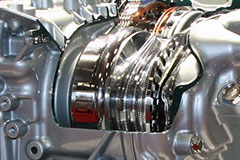Advantages of CVT Transmission - Vol.355
The transmission of an automobile is called a transmission because it transmits power from the engine to the wheels. The transmission does so by different ratios (from less than 1 to more than 1) to allow the engine, which is rather limited in range of speed, to generate a much wider range of wheel speeds.

Transmissions that most drivers know of are the type that works in fixed ratios: first gear, second gear, third gear, and so forth. The changing of gear can be manual or automatic. This is all fine and dandy except there is a better way of working the ratios, which is to vary the ratio continuously from the lowest to the highest ratio without any fixed steps.
Think of it this way. It's like you can automatically changes gear from gear 3 to gear 3.1, 3.2, and then to 1.55 or 3.91 or some variable ratio. You're no longer limited to a fixed number of gears. This type of automatic transmission is called continuously variable transmission (CVT), as opposed to the conventional step-gear automatic transmission.
The Major Advantages
CVT transmissionsare gearless. This is why they can be manufactured for less than conventional automatic transmissions. Instead of hundreds of precision-machined moving parts, CVT transmissions have only 3 major moving parts, which are a belt or a chain moving over two cones (or cone-like contraptions) that are parallel but facing the opposite direction.
One of the cones is a driver and the other one is being driven. The lowest ratio is when the belt is on the smallest part of the driver cone and the thickest part of the driven cone (like the lowest or first gear), and this ratio is continuously variable up to the highest ratio which is when the belt is on the thickest part of the driver cone and the smallest part of the driven cone (like the highest gear).
The result of this continuous variability is better engine efficiency at all speeds. Simpler and having less moving parts also means that it requires less power to operate a CVT transmission than a conventional step-gear automatic transmission. The result is better fuel efficiency and higher effective engine power.
For example, Nissan claimed that the fuel economy of their vehicles with CVT transmission is about 10 to 12% better than if the vehicles had utilized conventional automatic transmissions of the same class.
The percentage of vehicles sold that use CVT technology is fast increasing. One characteristic is that many of these vehicles have smaller engines. This is because vehicles with smaller engine capacity would be able to better take advantage of CVT transmission's higher power efficiency. For example, if you have 500 horses you really don't care if your transmission has to use up some of it, but if you only have 120 horses, you might want to count every last one of them.
The Other Advantages
A CVT transmission also gives the vehicle a smoother ride and it can rev the engine almost instantaneously for better torque response, instead of having to downshift like a conventional transmission.
The downside to this otherwise clear advantage is that people who are used to driving with conventional transmissions would complain that CVT transmissions don't give the type of acceleration that you can feel when you drag a gear before upshifting.
This is a prejudiced disadvantage that CVT technology should be able to overcome as it becomes more and more common. After all, back in the days there were driving enthusiasts who proclaimed that they would never pick automatic over manual, but look how far the automatic transmission has come. Over 90% of cars sold these days are auto, and for that reason it's become more expensive for manufacturers to make cars with manual transmission.
CVT transmissions are already more affordable and the technology is constantly improved and refined. There's a good chance CVT might just take over the world.